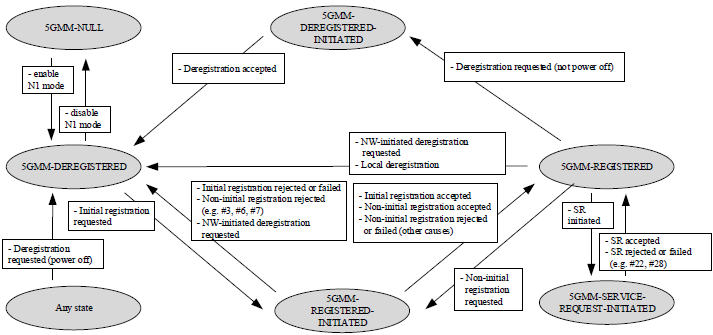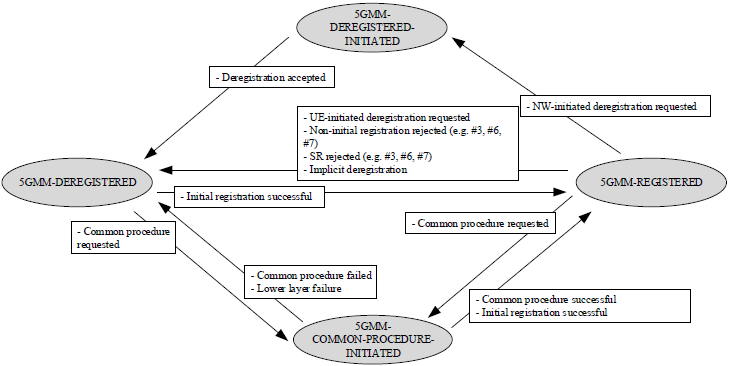|
5GMM(5G Mobility Management)
5GMM, or 5G Mobility Management, is the sublayer within the 5G NAS protocol that governs how a mobile device connects to, remains registered with, and moves within the 5G core network. It is responsible for establishing and maintaining the device’s mobility context, ensuring that the network is always aware of the device’s availability and general location for service delivery. Through procedures such as registration, deregistration, mobility updates, and paging response, 5GMM enables seamless connectivity as the device powers on, changes locations, or transitions between different access technologies. It also plays a key role in initiating authentication, setting up security contexts, and coordinating with other NAS functions so that both signaling and user data are exchanged securely and reliably across the network.
5G Mobile Management is involved mainly in NAS registration process and in terms of corenetwork interface point of view, it is mostly associated with N1/N2 interface.
Some of the major functionality of 5GMM is as follows (as described in 24.501-5.1.2) .
- registration
- de-registration
- eCall inactivity procedure
- connected mode procedure
- network-initiated NAS transport
- primary authentication and key agreement procedure
- security mode control
- generic UE configuration update
- identification
- UE-initiated NAS transport
- connection management procedure
- service request
- paging
- notification
5GMM is very complicated process described in about 150 pages in 24.501 and you would easily get lost if you directly jumping into reading the details. My recommendation is to try to get familiar with the following statemachine to the point where you can draw the statemachine by hands and then read the specification as-you-need basis.
GMM states on UE side is specified / summarized as shown below.
< 24.501 Figure 5.1.3.2.1.1.1: 5GMM main states in the UE >

Followings are brief description on each of the states. Understanding the details of each of the status and transition trigger would be helpful for you to troubleshoot various NAS issues from UE log.
- 5GMM-NULL: This state represents the initial condition when the UE is powered on or reset. In this state, 5GS services are disabled in the UE. No 5GS mobility management function shall be performed in this state. The UE is not registered to any 5G network, and no context is stored in the
network
for the UE. The UE is not reachable for mobile-terminated services.
- 5GMM-DEREGISTERED: In this state, the UE is not registered to any 5G network. No 5GMM context has been established and the UE location is unknown to the network and hence it is unreachable by a network. In order to establish a 5GMM context, the UE shall start the initial registration procedure. It
is either switched off, out of coverage, or has been deregistered from the network for some reason. The UE is not reachable for mobile-terminated services, and no context is stored in the network for the UE.
- 5GMM-DEREGISTERED-INITIATED: This state indicates that the UE has initiated the deregistration process but has not yet completed it. The UE is in the process of exchanging messages with the network to complete the deregistration.
- 5GMM-REGISTERED-INITIATED: In this state, the UE has initiated the registration process but has not yet completed it. The UE is in the process of exchanging messages with the network to complete the registration.
- 5GMM-REGISTERED: This state indicates that the UE has successfully registered with a 5G network. In this state, the UE can receive mobile-terminated services, and the network maintains context information for the UE. This state implies that the UE has successfully completed the registration process
and
can now utilize network services.
- 5GMM-SERVICE-REQUEST-INITIATED: In this state, the UE has initiated a service request to the network to establish a connection. This typically occurs when the UE needs to access specific network services or resources (e.g., to initiate a data session or a voice call). The UE remains in this state
until
the service request is either granted or rejected by the network.
According to 24.501 - 5.1.3.2.1.3 and 5.1.3.2.1.4, various substatus are defined as summarized below.
|
Main 5GMM State
|
Sub-State
|
Description
|
|
5GMM-DEREGISTERED
|
5GMM-DEREGISTERED.NORMAL-SERVICE
|
UE is not registered and actively searching for a network to register with.
|
|
5GMM-DEREGISTERED.LIMITED-SERVICE
|
UE has limited network access, typically due to an emergency or restricted access for specific services.
|
|
5GMM-DEREGISTERED.ATTEMPTING-REGISTRATION
|
UE is attempting to register with a network but has not yet completed the process.
|
|
5GMM-DEREGISTERED.PLMN-SEARCH
|
UE is searching for a suitable Public Land Mobile Network (PLMN) to register with.
|
|
5GMM-DEREGISTERED.NO-SUPI
|
UE does not have a Subscription Permanent Identifier (SUPI) or is not able to use it for registration.
|
|
5GMM-DEREGISTERED.NO-CELL-AVAILABLE
|
UE is not able to find a suitable cell to register with or is out of coverage.
|
|
5GMM-DEREGISTERED.eCALL-INACTIVE
|
UE is not registered and not actively searching for a network, with eCall functionality inactive.
|
|
5GMM-DEREGISTERED.INITIAL-REGISTRATION-NEEDED
|
UE needs to perform an initial registration with a network.
|
|
5GMM-REGISTERED
|
5GMM-REGISTERED.NORMAL-SERVICE
|
UE is registered and has normal network access for all services.
|
|
5GMM-REGISTERED.NON-ALLOWED-SERVICE
|
UE is registered but does not have access to specific services, as defined by the network.
|
|
5GMM-REGISTERED.ATTEMPTING-REGISTRATION-UPDATE
|
UE is attempting to update its registration with the network, typically due to mobility or changes in the network.
|
|
5GMM-REGISTERED.LIMITED-SERVICE
|
UE has limited network access, typically due to an emergency or restricted access for specific services.
|
|
5GMM-REGISTERED.PLMN-SEARCH
|
UE is searching for a new PLMN while still being registered
|
|
5GMM-REGISTERED.NO-CELL-AVAILABLE
|
UE is registered but there is no cell available for communication.
|
|
5GMM-REGISTERED.UPDATE-NEEDED
|
UE needs to update its registration information, typically due to changes in subscription data or network configuration.
|
GMM states on Network side is specified / summarized as shown below.
< 24.501 Figure 5.1.3.2.3.1.1: 5GMM main states in the network >

Followings are brief description on each of the states
- 5GMM-DEREGISTERED:
- UE: Not registered to the network and cannot access network services.
- Network: In this state, the network does not provide any services to the UE. The network can still monitor for registration attempts from the UE and be ready to process any incoming registration requests. The network can also initiate paging if the UE had a valid registration earlier and needs to be reached for incoming communication.
- 5GMM-DEREGISTERED-INITIATED:
- UE: Initiated a deregistration process with the network.
- Network: During this state, the network processes the deregistration request, updates the UE's context information, and releases any allocated resources. The network can also acknowledge the completion of the deregistration process or initiate a re-registration process if required.
- 5GMM-COMMON-PROCEDURE-INITIATED:
- UE: Initiated one or more common procedures with the network.
- Network: In this state, the network processes the UE's request for common procedures, such as registration, service request, and paging. The network can also initiate these procedures, allocate resources, and manage the UE's context information. Additionally, the network can handle any errors or exceptions that may occur during these procedures.
- 5GMM-REGISTERED:
- UE: Successfully registered to the network and can access network services.
- Network: In this state, the network provides services to the registered UE, such as data and voice communication. The network can also manage the UE's mobility by updating its registration when the UE moves between different network areas. The network can initiate procedures such as periodic registration updates, tracking area updates, or paging to maintain the connection with
the UE. Furthermore, the network can enforce access restrictions, quality of service, and security policies for the registered UE.
Followings are the list of NAS signaling (OTA procedure) handled by 5GMM. I think these message (process) list would give more concrete idea to most of the readers since analyzing OTA message would be pretty common practice. I will create separate notes for each of these process and put the link as I complete the note... but not sure how long it will take to complete all of them, but
I will try to complete at least 5G specific process as early as possible. For most of other procedures, I think you can apply your LTE knowledge. Each of NAS messages involved in each of these procedures are described in 24.501-8.2.
- Authentication
- Registration
- UL/DL NAS Transport
- De-Registration
- Service Setup
- Configuration Update
- Identify Query
- Notification
- Security Mode Setup
- 5GMM Status
Reference
|
|

